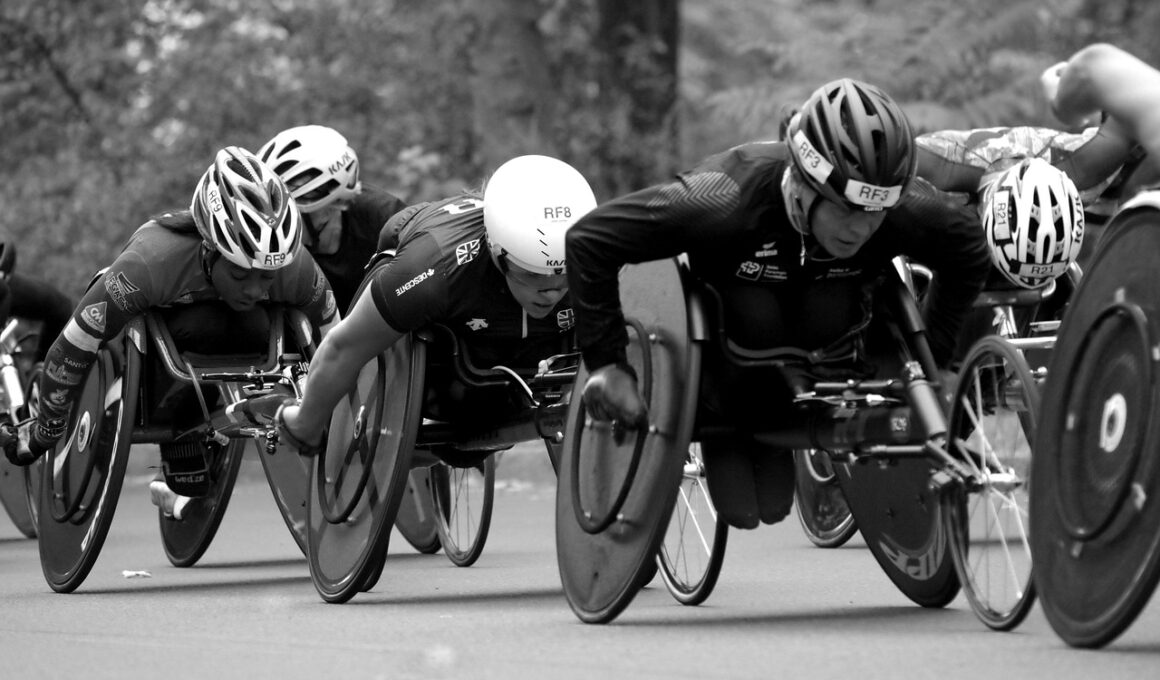How to Assess a Disabled Dog’s Ability for Different Sports
When introducing sports to a disabled dog, it is essential to understand their unique capabilities. Each dog has different needs, particularly if they face mobility challenges or sensory issues. Evaluation begins with observing their general behavior and comfort level in various environments. Check for enthusiasm towards physical activity and their ability to communicate enjoyment, which is crucial for any sport. This assessment can help determine the types of sports that may be suitable. Consult with a veterinarian or a canine rehabilitation specialist for input on any underlying health concerns that may affect participation. Take note of your dog’s physical limitations, including range of motion in joints, strength, and stamina. Understanding these factors can help you choose activities that align with their abilities while keeping them engaged. Additionally, note any compensatory behaviors they may exhibit in response to their disabilities. Encourage your dog to participate in play sessions and assess their reactions and performance. With patience and gradual introduction, your dog may discover new loves and abilities. Focus on creating a supportive environment for them to thrive and enjoy the sports tailored for them.
After determining your dog’s strengths and limitations, it’s time to explore suitable sports for them. Not all sports are appropriate for disabled dogs, so careful research is vital. Some suitable options might include swimming, adaptive agility, or even scent work which focuses on their keen sense of smell. These sports can be advantageous as they don’t place excessive strain on joints or require high agility levels. Swimming is particularly appealing because it minimizes the risk of injury, allowing dogs to exercise without putting weight on their limbs. In contrast, adaptive agility can be modified to fit various abilities, encouraging movement without overwhelming them. Scent work taps into an essential skill that many dogs naturally possess and provides a gratifying experience through mental engagement. However, ensuring safety is paramount when selecting any sport. Clear an appropriate space to prevent injuries and supervise them closely. Observe how your dog reacts to different activities, as their willingness to engage indicates their interest. Engaging your dog in these sports can foster confidence while providing fun for you both. Remember to gradually build intensity and variety to keep your dog motivated and excited throughout their sporting pursuits.
Assessing Physical and Emotional Readiness
Evaluating a disabled dog’s emotional and physical readiness for sporting activities is critical. Observe their temperament during playtime and how they respond to challenges. Look for signs of enthusiasm, affection, and willingness to engage, which indicate a positive emotional state. If your dog tends to become anxious or withdrawn, seek advice from a dog trainer or behaviorist. They can help you work on building confidence and comfort through engaging exercises. Also, pay close attention to their physical readiness by checking for pain or discomfort during normal activities. A physical assessment should include observing movements, help with testing mobility, and consulting with a veterinarian for a professional opinion on specific exercises. Consider using harnesses or equipment designed for disabled dogs, as these can enhance performance and comfort. Additionally, assess whether your dog tends to tire quickly or struggles with core exercises. If they appear to have difficulty, it may not be prudent for them to participate in demanding activities. Start slowly and build toward more challenging sports while giving your dog sufficient rest breaks. Progress should always be paced according to their personal willingness and enjoyment.
Besides physical readiness and emotional stability, ensuring that the sport feels rewarding for your disabled dog is critical. Engage in various activities that encourage interaction and promote positive experiences. Sports should embrace your dog’s strengths while offering challenges that suit their capabilities. Consider simple elements of agility or obedience that can be adapted to fit your dog. Use positive reinforcement methods to motivate and encourage them when participating in these activities. Rewarding their efforts ensures they see the sport as a positive experience. Setting achievable and clear goals will help both you and your dog work towards mastering new skills in a fun way. Additionally, record their experiences and progress through regular check-ins, celebrating small accomplishments that can motivate continued engagement. Participating together creates a bond, enriching both of your lives. Evaluate your dog’s enthusiasm towards activities and their ability to relax afterward, ensuring that there is a balance between exertion and enjoyment throughout. When your dog appears excited and ready to engage, it shows that both of you are on the right path towards enjoyable sporting adventures.
Adapting Activities for Individual Needs
Once you’ve identified the appropriate sports, adapting them to meet your disabled dog’s unique needs is essential. Tailoring activities can make the sports more accessible and enjoyable for your dog, ensuring they never feel overwhelmed. Utilizing equipment like ramps or specialized harnesses can help dogs with mobility issues participate more fully. Choose clear and engaging exercises that emphasize your dog’s abilities rather than their disabling conditions. Keep playtime flexible, allowing for modifications as your dog requires. Incorporating rest periods into activities and letting them take breaks is vital for their welfare. Frequent adjustments prevent fatigue or injury, ensuring the training remains enjoyable. Owners should also remain patient as dogs learn new sports, understanding that some dogs may need more time to adapt than others. Always encourage lighthearted play, allowing your dog to explore activities at their own pace without pressure. Observing their responses can provide essential feedback on how well the sport aligns with their abilities. Each small progression can build confidence and encourage a positive relationship with sporting activities. Adaptation focuses not only on physical adjustments but also the emotional aspects of keeping your dog engaged in the fun as they discover new experiences.
Socialization plays a vital role in engaging dogs with disabilities in sports. Participating in sports that involve other dogs or people can enhance your dog’s social skills and create bonds. Group activities encourage your dog to develop healthy interactions while learning from peers. This can help alleviate feeling left behind or isolated, which can sometimes accompany disability. Introduce socialization gradually, starting with controlled environments where your dog feels confident and secure. As they build confidence, increase exposure to new outdoor settings and other dogs. Group-based sports like adapted agility training can provide opportunities for your dog to interact with others. Make sure to monitor your dog’s interactions, intervening when necessary to ensure they feel safe. Proper socialization can also help build resilience, making your dog feel more comfortable navigating different environments. It further fosters a sense of community that can be rewarding for both dogs and their owners. Always select compatible playmates and settings to ensure a positive experience. A well-socialized dog is likely to thrive in any sports environment, opening up more opportunities for learning and growth while reducing anxiety during engagements.
Maintaining a Positive Experience
In conclusion, maintaining a positive experience for disabled dogs engaged in sports is crucial to their enjoyment and health. Encouragement and a supportive environment facilitate learning and engagement, making the process enjoyable for both owners and their pets. Pay attention to your dog’s reactions during activities, celebrating progress and understanding when to adjust expectations. The key is to promote a friendly atmosphere that ensures safety while preserving their enthusiasm for sports. Outcomes can vary as each dog has unique abilities and limits, which need to be embraced throughout the process. Incorporate diverse activities spread across different sessions to keep them excited and engaged. This variety maintains novelty and encourages exploration, which can lead to unexpected discoveries in the dog’s physical capabilities. Make use of techniques such as clicker training or verbal cues for encouraging participation. Learning should be stress-free and ultimately enjoyable, steering clear of frustration. Encourage your dog to explore multiple sports types for a broader engagement experience. As your dog discovers new abilities, you’ll be amazed at what they can achieve with the right support and encouragement. Explore together and cherish the journey!


